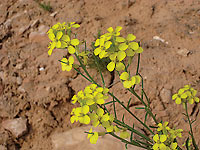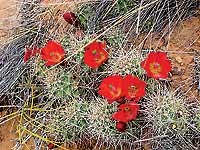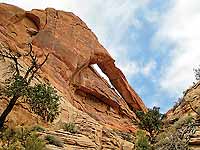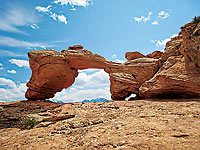The jagged profile of the Moab Rim is a geological wonder that never ceases to amaze me. How could I possibly get bored with the powerful stance of this 1800 foot Navajo Sandstone precipice that dominates Moab’s southwestern skyline? Beyond the walls of this formidable fortress known as Behind The Rocks exists an expansive, untamed landscape – a mysterious maze of slickrock, fins, domes, hidden gardens, giant alcoves, deep pools and sharply cut canyons - a precious resource in which 12,635 acres have been designated as the Behind The Rocks Wilderness Study Area.
 On a beautiful spring morning in mid-April I’m on my way to the southern end of this spectacular region to revisit two uniquely different arches – Moab Rim and Tukuhnikivista. Arches are fascinating geological creations and water erosion is usually the main factor in their formation. It begins at weak points within the sandstone when chemicals in the water dissolve the cement that binds the rock particles together. Then expanding pressure from water and ice slowly breaks off pieces of stone until many of the fins collapse. But some with the right balance and hardness survive as arches, and geologists believe that most of them were created within the last million years.
On a beautiful spring morning in mid-April I’m on my way to the southern end of this spectacular region to revisit two uniquely different arches – Moab Rim and Tukuhnikivista. Arches are fascinating geological creations and water erosion is usually the main factor in their formation. It begins at weak points within the sandstone when chemicals in the water dissolve the cement that binds the rock particles together. Then expanding pressure from water and ice slowly breaks off pieces of stone until many of the fins collapse. But some with the right balance and hardness survive as arches, and geologists believe that most of them were created within the last million years.
My access point is 12 miles south of Moab on Highway 191. When the road starts uphill, I take a right on to a dirt road just before mile marker 114. After driving a very short distance, I conveniently park at the Behind The Rocks jeep trail sign.
Another well-used entrance is at the top of Blue Hill, 1.4 miles further down the highway. Heading north on this dirt road requires a high clearance four-wheel drive vehicle. I, however, prefer to walk rather than jounce around, and the route I am taking is the shortest, least crowded and most direct for a hiker.
 Just as I’m ready to embark on my hike I spy a medium-sized gray bird on top of a juniper. Oh Wow, it’s a mockingbird - a rare visitor to southeast Utah with an astounding ability to imitate in a very powerful voice the songs of other birds.
Just as I’m ready to embark on my hike I spy a medium-sized gray bird on top of a juniper. Oh Wow, it’s a mockingbird - a rare visitor to southeast Utah with an astounding ability to imitate in a very powerful voice the songs of other birds.
I grab my pack and move along over a very extreme - You’ve got to be joking! – jeep trail. The path of black covering the rock ledges, however, proves it’s been done successfully many times!
Almost immediately a series of buzzy notes - a rendition of “zeedle, zeedle, zeedle, zeetchee” - grabs my attention. Ah ha, the black-throated gray warblers have returned. Their winter vacation in Mexico over, it’s back to the business of setting up a territory and raising a family. Shortly after that I hear the clucking sounds of a chukar who is alerting the rest of the flock to my presence in their domain. Introduced from Pakistan, these transplanted game birds thrive in arid rocky terrain, and the area in Behind The Rocks seems to suit them just fine.
 Along with the satisfaction of identifying three out-of-the ordinary birds I am also delighted to be here at the peak of the wildflower season. This is a spectacular show I never want to miss - the brilliant red of the Indian paintbrush - the waltzing abundance of yellow wallflowers gently swaying and dancing in the breeze - the sweet fragrance of the cliffrose carried dozens of feet from its source – and the loveliness of the red tubular flowers of Eaton’s pentstemon.
Along with the satisfaction of identifying three out-of-the ordinary birds I am also delighted to be here at the peak of the wildflower season. This is a spectacular show I never want to miss - the brilliant red of the Indian paintbrush - the waltzing abundance of yellow wallflowers gently swaying and dancing in the breeze - the sweet fragrance of the cliffrose carried dozens of feet from its source – and the loveliness of the red tubular flowers of Eaton’s pentstemon.
Gradually the road ends at an intersection – the same road that starts at Blue Hill - where a sign points right to a much easier section of the Behind The Rocks trail. Now I’m strolling through an abundance of blackbrush and sagebrush with its pungent odor of turpentine.
 When the jeep trail swings sharply to the left, I follow a dead-end road that goes straight ahead. After a steep drop, it snakes a course just below the jagged-edged rim – an intriguing procession of protruding towers, hefty blocks, and rounded monoliths – a fascinating endless parade of scalloped rocks, big rocks with flat-capped hats, tilted rocks, gracefully curvaceous rocks and ready-to-slide-away rocks.
When the jeep trail swings sharply to the left, I follow a dead-end road that goes straight ahead. After a steep drop, it snakes a course just below the jagged-edged rim – an intriguing procession of protruding towers, hefty blocks, and rounded monoliths – a fascinating endless parade of scalloped rocks, big rocks with flat-capped hats, tilted rocks, gracefully curvaceous rocks and ready-to-slide-away rocks.
Then finally - around the big bend there it is - Moab Rim Arch. At first glance its appearance suggests a huge alcove. Only when you are up close and personal does its arch-ness become apparent. Scrambling up to the base of this monster-sized portal, which is not an easy thing to do, I find the prizewinner of the wildflower show – the dazzling red blooms of the claret cup cactus.
 Immediately after that, the odd shape of Tukuhnikivista Arch appears on the skyline – a curvature above the rock wall with the striking appearance of a bent over finger – so small and fragile looking it feels like a brisk wind could knock it over.
Immediately after that, the odd shape of Tukuhnikivista Arch appears on the skyline – a curvature above the rock wall with the striking appearance of a bent over finger – so small and fragile looking it feels like a brisk wind could knock it over.
By the time the road ends at the boundary for the Wilderness Study Area, this elusive arch has disappeared from view. Seeking the best route to it I pick my way over a footpath that angles to the right through some fins. At a wall of steep slickrock, the trail fades away, and on blind faith I forge on following the course of least resistance. Suddenly it shows up again. Hallelujah I’m almost there! Gaining 1500 feet in approximately three miles makes me realize determination is paying off!
Once on the rim a short stroll south places me next to this teeny-weeny arch, a fascinating formation that now bears a striking resemblance to a horse’s head. Encircled by the embracing arms of this small opening I can picture-frame Mt. Tukuhnikivatz, the feature that gave this arch its curious name. Now I am ready to reap the rewards of this picturesque setting as I gaze out at a far distant landscape: Ken’s Lake campground, Faux Falls, the road to Flat Pass, Mill Creek Canyon, South Mesa, the entire range of the La Sal Mountains, Black Ridge and Pack Creek Ranch.
This scene atop the backbone of Behind The Rocks is too special to be rushed and so I linger long enough to deeply contemplate the tale of two very different arches – the shy hidden giant versus the cocky midget that jauntily perches on the skyline. Each has its own unique personality and appeal, which is what has made this journey so intriguing.
 On a beautiful spring morning in mid-April I’m on my way to the southern end of this spectacular region to revisit two uniquely different arches – Moab Rim and Tukuhnikivista. Arches are fascinating geological creations and water erosion is usually the main factor in their formation. It begins at weak points within the sandstone when chemicals in the water dissolve the cement that binds the rock particles together. Then expanding pressure from water and ice slowly breaks off pieces of stone until many of the fins collapse. But some with the right balance and hardness survive as arches, and geologists believe that most of them were created within the last million years.
On a beautiful spring morning in mid-April I’m on my way to the southern end of this spectacular region to revisit two uniquely different arches – Moab Rim and Tukuhnikivista. Arches are fascinating geological creations and water erosion is usually the main factor in their formation. It begins at weak points within the sandstone when chemicals in the water dissolve the cement that binds the rock particles together. Then expanding pressure from water and ice slowly breaks off pieces of stone until many of the fins collapse. But some with the right balance and hardness survive as arches, and geologists believe that most of them were created within the last million years.  Just as I’m ready to embark on my hike I spy a medium-sized gray bird on top of a juniper. Oh Wow, it’s a mockingbird - a rare visitor to southeast Utah with an astounding ability to imitate in a very powerful voice the songs of other birds.
Just as I’m ready to embark on my hike I spy a medium-sized gray bird on top of a juniper. Oh Wow, it’s a mockingbird - a rare visitor to southeast Utah with an astounding ability to imitate in a very powerful voice the songs of other birds.  Along with the satisfaction of identifying three out-of-the ordinary birds I am also delighted to be here at the peak of the wildflower season. This is a spectacular show I never want to miss - the brilliant red of the Indian paintbrush - the waltzing abundance of yellow wallflowers gently swaying and dancing in the breeze - the sweet fragrance of the cliffrose carried dozens of feet from its source – and the loveliness of the red tubular flowers of Eaton’s pentstemon.
Along with the satisfaction of identifying three out-of-the ordinary birds I am also delighted to be here at the peak of the wildflower season. This is a spectacular show I never want to miss - the brilliant red of the Indian paintbrush - the waltzing abundance of yellow wallflowers gently swaying and dancing in the breeze - the sweet fragrance of the cliffrose carried dozens of feet from its source – and the loveliness of the red tubular flowers of Eaton’s pentstemon.  When the jeep trail swings sharply to the left, I follow a dead-end road that goes straight ahead. After a steep drop, it snakes a course just below the jagged-edged rim – an intriguing procession of protruding towers, hefty blocks, and rounded monoliths – a fascinating endless parade of scalloped rocks, big rocks with flat-capped hats, tilted rocks, gracefully curvaceous rocks and ready-to-slide-away rocks.
When the jeep trail swings sharply to the left, I follow a dead-end road that goes straight ahead. After a steep drop, it snakes a course just below the jagged-edged rim – an intriguing procession of protruding towers, hefty blocks, and rounded monoliths – a fascinating endless parade of scalloped rocks, big rocks with flat-capped hats, tilted rocks, gracefully curvaceous rocks and ready-to-slide-away rocks.  Immediately after that, the odd shape of Tukuhnikivista Arch appears on the skyline – a curvature above the rock wall with the striking appearance of a bent over finger – so small and fragile looking it feels like a brisk wind could knock it over.
Immediately after that, the odd shape of Tukuhnikivista Arch appears on the skyline – a curvature above the rock wall with the striking appearance of a bent over finger – so small and fragile looking it feels like a brisk wind could knock it over.